Sunday 30 December 2007
Sporting Shooter podcast - episode 7
Friday 28 December 2007
Boxing Day squirrel shoot
After all that turkey and Christmas pudding, what's needed is a bit of fresh air and healthy outdoor exercise. Better still if you can combine it with a spot of conservation work - reducing the population of grey squirrels. OK, there's no red squirrels within miles of my parents' place on the North Downs, but the greys do plenty of damage to forestry, native birds and fruit trees, so we do our best to keep their numbers down.
There was a broad cross-section of the family out on the traditional Boxing Day 'poke'. Not to be outdone by her sister's exploits, younger daughter Vicky was out with a 12-bore pump-action Remy 870, a good choice for the squirrels.
Chief poker was my dad, ably assisted by the Australian contingent of Deon and Jacob. We worked through the woods, using the segmented poles to poke the squirrel dreys while Emma, Vicky and my brother Nigel stood ready to shoot any that appeared.
As is often the case, many of the dreys were empty. But we still managed three, one of them falling to a delighted Vicky. Plus in-between taking the photos I collected a pigeon that was foolish enough to fly within range.
All in all, a small victory for conservation, and a good day had by all.
Emma's first pheasant
Christmas Eve saw the family out at a pheasant shoot near Horsham in Sussex, where my mum had generously given up her gun so my elder daughter Emma could get her first taste of driven pheasant shooting.
It's always a friendly, family-based shoot, and all the more so being so close to Christmas. It was touching to see everyone, from the beaters to the shoot owner, making Emma feel welcome - and genuinely thrilled when she shot her first pheasant.
The bird was kept separate from the main bag so that Emma could bring it home, and after a few days' hanging it will be turned into a very special meal.
Monday 24 December 2007
Goose shooting in Aberdeenshire
Spent 3 days in Aberdeenshire with our prizewinning young shots, who won the competition in the magazine earlier this year for two days of goose and duck shooting with noted goose guide Andrew Richardson of Safari in Scotland.
Andrew laid on the trip of a lifetime for the five youngsters, starting with an unforgettable dawn decoying session on a field of winter barley. We arrived in pitch dark (and minus 6 degrees!). Andrew's partner, Mark, set up a hide against a wall, with a pattern of huge "magnum" goose decoys that looked as big as bathtubs!
As the sky lightened we were treated to the awesome sight and sound of thousands of pinkfeet heading from their roost straight towards our decoys. Time after time small groups would break off, set their wings, and glide in to the pattern.
The youngsters shot well, and eventually Mark called a halt when they had reached their bag limit of six geese each - a total of 30 pinks in the bag.
That evening we went flighting ducks at a local pond. It was virtually dark when the first ducks appeared, looking like shadows against the darkening sky (hence the rather dark video below). Once again the youngsters shot remarkably well, and put a total of 24 mallard and wigeon in the bag.
Finally, the next morning we went out for another goose flight. This time the geese were less eager to come in to the decoys. Mark and Andrew reckoned this was because they had been feeding under the moon the night before. 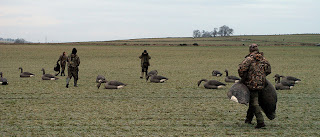
We still saw literally thousands of geese, and our young shots managed a bag of six between them, so a good time was had by all. We would have had another duck flight in the evening, but by now all the ponds in the area were frozen over.
Congratulations to our winning young shots - you can read about their adventure in the March issue of Sporting Shooter.
Geese under the moon
While I was in Aberdeenshire with Andrew and Mark of Safari in Scotland, conditions came right for flighting geese under the moon. Andrew explained that this is something that happens so rarely that most shooters only experience a moonflight once or twice in a lifetime, so it was a real privilege.
The moon needs to be between three-quarters and full, and you need a thin, even cloud cover. The cloud is lit up by the moon, and provides a light backdrop against which you can see the geese; too much cloud and it's just too dark, too little and you can't see them against the black night sky.
We set off to a field of winter barley after dinner; Mark was already there and had a couple of geese. The scene was magical - the hazy moon shining down through the cloud, lighting up the frosty winter barley enough that we could walk around easily with no need for a torch.
The pinks seemed to be all around us, calling loudly, with Andy and Mark using their calls to try to lure them close enough.
We stayed on the field for a couple of hours in a temperature of minus 8, and I was so excited to be there I never even noticed the cold. Eventually the cloud thinned out too much, and we could no longer see the birds even straight over our heads. By then there were six pinks in the bag.
It was a wonderful experience, one of those things that money just can't buy. I feel very lucky.
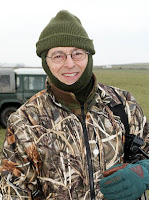 Footnote: Cold weather clothing Standing around in temperatures as low as -8degC needs some serious clothing. I was wearing, on my upper body: long-sleeved T-shirt, microfleece shirt, fleece jacket, and a Deerhunter outer fleece with a wetlands-type Realtree camo pattern. On my legs: fleece trousers (same material as the fleece top, with Shark waterproof trousers over. On my head: wool/acrylic balaclava, plus wool hat. Feet: thin socks, thick socks and a pair of Dubarry boots. Hands were a problem, as my well insulated skiing gloves made it impossible to operate the camera. In the end I wore a skiing glove on my left hand, and woollen mitt on my right; the fingers on my right hand went numb, but at least I could still work the shutter.
Footnote: Cold weather clothing Standing around in temperatures as low as -8degC needs some serious clothing. I was wearing, on my upper body: long-sleeved T-shirt, microfleece shirt, fleece jacket, and a Deerhunter outer fleece with a wetlands-type Realtree camo pattern. On my legs: fleece trousers (same material as the fleece top, with Shark waterproof trousers over. On my head: wool/acrylic balaclava, plus wool hat. Feet: thin socks, thick socks and a pair of Dubarry boots. Hands were a problem, as my well insulated skiing gloves made it impossible to operate the camera. In the end I wore a skiing glove on my left hand, and woollen mitt on my right; the fingers on my right hand went numb, but at least I could still work the shutter.Wearing that lot, I was comfortable enough so long as I was out of the wind. If it had been very windy, or raining, a heavier and waterproof top coat would have been needed, plus a hood or waterproof hat, and perhaps a scarf.
Wednesday 19 December 2007
Suburban Bushwacker
I was inspired by SBW's enthusiasm to throw himself into shooting, hunting and eating, and more than happy to offer advice and practical help where I can. With fewer and fewer people being brought up the country way, every urban (or suburban) convert has to be a step in the right direction.
I hope we can feature SBW's progress in the mag (and on this blog) as he gets involved in activities like ferreting, learns about guns and shooting, and ultimately reaches his goal of shooting and cooking his own dinner.
Meanwhile, I have to head north to watch some young readers shoot geese in Aberdeenshire. I don't suppose we'll get much of an internet connection in the hotel, so you'll have to wait for my return to find out how we got on. And if I'm not back in time, Happy Christmas!
Tweeded toffs
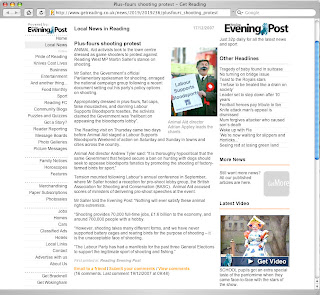 There's a lesson for shooting here. Animal Aid took to the streets of Reading to protest about Labour MP Martin Salter's stance on shooting (broadly supportive). To his credit, he stood firm: “Nothing will ever satisfy these animal rights extremists," he told the Reading Evening Post.
There's a lesson for shooting here. Animal Aid took to the streets of Reading to protest about Labour MP Martin Salter's stance on shooting (broadly supportive). To his credit, he stood firm: “Nothing will ever satisfy these animal rights extremists," he told the Reading Evening Post.But look at how the animal nutters made their protest. They dressed up as pantomime tweeded toffs. Why? Because everyone loves to hate an arrogant upper class twit. So if you want the public to support a ban on shooting, you encourage them to believe shooters are like that. It worked when they wanted to ban hunting, and they hope it will work again with shooting.
Shooting associations take note. Your spokesmen should never talk with a remotely posh accent, and should never dress in tweed, or you're playing into their hands.
Tuesday 18 December 2007
Hunting on TV
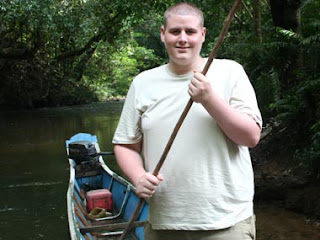 Imagine my surprise when I turned on the TV last night to see a handful of British teenagers hunting wild boar with a pack of dogs and spears - on the BBC no less, and at prime evening viewing time too.
Imagine my surprise when I turned on the TV last night to see a handful of British teenagers hunting wild boar with a pack of dogs and spears - on the BBC no less, and at prime evening viewing time too. The boar was chased with dogs and brought to bay at the top of a waterfall. Eventually it was goaded over the edge and splashed into the pool below, where one of the intrepid lads stabbed it to death with a sharpened bamboo pole. The proud hunter carried his prize home, where it was roasted and enjoyed by the hunting party and their friends and relatives.
Most surprising of all was the tone of the programme. The teenagers were praised for their enthusiasm and determination. The narrator pointed out that this was healthy, natural food. Nobody asked the animal rights nutters for their opinion.
This is Can Fat Teens Hunt? a programme that takes ten "dangerously overweight" teenagers to live the hunter-gatherer lifestyle with the Iban tribe in Borneo - in the hope they will discover a new respect for food, and for themselves and their own bodies.
I'm torn between hating the crassness of the theme, and loving the idea of the BBC showing hunting in such a positive light. Not long ago, political correctness would have stamped on the very idea of this type of programme. Now it's just a logical extension of "extreme reality" programmes and the growing fad for "getting back to nature" by killing your own food (demonstrated by Jamie Oliver, Wild Gourmets, Roadkill Chef and many more).
In fact, the BBC's obsession with animals being killed to eat is becoming almost morbid, with Kill It, Cook It, Eat It tracing an animal's journey from farm to plate. Along the way "a group of specially invited people, from vegetarians to meat enthusiasts, will witness the slaughter," gloats the press release.
Still, it demonstrates a refreshing honesty about where food comes from, which in my experience is stimulating a new interest in shooting and other aspects of the countryside. Shooters should not just welcome this new trend, we should be jumping on the bandwagon!
Monday 17 December 2007
Bushnell 'Infinity' binoculars
 JJ Vickers kindly loaned me a pair of their Bushnell 'Infinity' 10.5x45 binoculars a few weeks back. The pre-Christmas rush has made it difficult to give them a thorough test, but so far I've been hugely impressed.
JJ Vickers kindly loaned me a pair of their Bushnell 'Infinity' 10.5x45 binoculars a few weeks back. The pre-Christmas rush has made it difficult to give them a thorough test, but so far I've been hugely impressed.In a nutshell, they are rubber-armoured, rugged, and claim to be lightweight, waterproof and fogproof. At £420 (£400 for the 8.5x45s) they're not exactly cheap, but they're not the most expensive binoculars around either. Neither are they exactly lightweight, at 723g (25.5oz in old money). I imagine that if you were mugged, they would make a handy weapon, swung by the strap - and they're that solid I bet they'd still work fine afterwards.
Waterproof? Well I was tempted to leave them in the garden pond for a couple of days, but guessed that Vickers might not be amused. They certainly look like they ought to be waterproof, and with that promise from Bushnell I can't believe they're anything but. (My Nikons never claimed to be waterproof, and sure enough they weren't, as I discovered when the dog unfortunately covered them with diarrhoea – I washed them off under the tap, and then spent a week trying to dry out the insides; they've never been quite the same since).
Back to the Bushnells: I like the focus adjustment, a large wheel that falls naturally under your fingers, and has raised rubber ribs making it easy to turn precisely. I find it useful to keep nudging the focus back and forth as I scan with binoculars, which helps with the old trick of looking through cover rather than at it. The wheel turns smoothly, and makes this easy to do.
The wheel also incorporates the adjustment of one eye relative to the other, in a rather clever way. A bit like changing the date on your watch, you pop the wheel out slightly until it clicks. Turn it a little this way and that, until the two images are correctly focused. Then pop the wheel back it, and the setting is saved for good - or at least until you decide to alter it. It's simple, it works, and it doesn't get knocked out of alignment, or messed up by the first numpty who decides to take a look through your binoculars and can't resist fiddling.
For people who wear glasses (like me) the eyepieces are easily retracted with a quick twist (about a quarter-turn) to allow a full view with glasses, or extended again to give proper eye-relief for those lucky folk who don't need glasses (and therefore aren't unduly hampered on a drizzly day!).
Other features: well, the strap attachment is rather over-engineered, in my opinion. Each end of the strap has a plastic stud, which snaps into a kind of keyhole arrangement in the body of the binoculars, with a sprung plastic latch to stop it slipping out again. It works, and it allows the binoculars to hinge on the stud. But it is bulkier than necessary, and I found it turns too easily, allowing the strap to get twisted as you put the binos down on the car seat and pick them up again, etc. I'd sooner have a simple recessed bar that the strap can pass through. Still, that's a relatively minor point. The strap itself is nice and wide, and well padded, making it comfortable to carry round the neck. I found it ridiculously long, and cut it down to a sensible length with a hot knife (sorry Vickers!).
There's a plastic cover for the eyepieces, with a ridged, flexible joining piece between the cups so it fits regardless of how far apart you've set the eyepieces. The strap passes through a slot , ensuring that the cover can't get lost. Someone has obviously put a bit of thought into this, and yet it still doesn't really work! You'd think that by now someone would have come up with the definitive lens cover for binoculars that just worked - something like those flip-up scope covers, for instance, that keep the lenses totally protected yet flips out of the way in an instant when you want to look through them. I've used all sorts of binoculars, including some seriously expensive models, and the lens covers all have their faults.
Anyway, enough beating about the bush; what are they like to look through? After all, that's what it's all about.
In a word, amazing! I've been using my pair of Nikon 8x42s for years, and I often feel smug when I compare them even to more expensive binos belonging to other shooters. The image is bright and sharp, and they seem to cut through twilight and deep shadow. These Bushnells are on another level. They are brighter, sharper, and they let me see more in twilight than I can with the Nikons - by a considerable margin. I really can spot deer etc with these some time after they've disappeared into a grey blur through my Nikons.
And that's despite the fact that these give 10.5x magnification against the Nikons' 8x, so in theory they have a smaller exit pupil and shouldn't perform so well in twilight. No doubt the 8.5x45s are better still.
The image is sharp, clear and bright right across the field of view (approx 100m @ 1000m), with excellent contrast and definition. Outstanding!
Nowadays you can buy surprisingly good optics for silly money in the high street, and many shooters choose to go that route, thinking of them as 'disposable' items that can be replaced cheaply when they fail. Then there are those (usually spending the estate's money rather than their own hard-earned) who go the 'buy the best' route.
These Bushnells fall somewhere between those two extremes. Their optical quality is outstanding, yet they're a good deal cheaper than the top-end stuff from the likes of Zeiss and Leica. For the average pigeon shooter or stalker who takes care of his gear and appreciates quality, they are going to be a very tempting option. If you're thinking of paying out serious money on a pair of binos, I'd recommend you take a look at these first.
No doubt about it, the Bushnell Infinity binos are considerably better in every way than my Nikons, dammit! Now Vickers will want them back, and I'll feel less than satisfied going back to the Nikons... and I'll end up replacing them at vast expense. Ah well, they say you can't take it with you...
'Award winning editor'
 Hypocrisy is a wonderful thing. If you'd asked me last week what I thought about awards, you'd have got a cynical answer. Now I'm the proud recipient of an editorial award from my employers Archant – and I'm rather enjoying all the attention.
Hypocrisy is a wonderful thing. If you'd asked me last week what I thought about awards, you'd have got a cynical answer. Now I'm the proud recipient of an editorial award from my employers Archant – and I'm rather enjoying all the attention.That photo of me and the ferrets has appeared in the Archant newsletter, and my equally hardworking and talented colleagues are getting every so slightly fed up with being told how blooming marvellous James is.
So expect to see "award winning editor" in the magazine's flannel panel... I shall enjoy my moment of glory, then it's back to business as usual...
Talking of which, I'm off to Aberdeen later this week to join a group of our prize-winning young shots, who are shooting geese with Andy Richardson. Watch this space for a report, photos, video and more...
Sunday 9 December 2007
Gleneagles and beyond with Benelli

I'm just back from a fascinating trip to Scotland, courtesy of Italian gunmaker Benelli who are keen to promote their 20-bore semi-autos for rough shooting. Our group of 35 comprised gun distributors and sporting journalists from all over Europe. We stayed at the fabulous Gleneagles Hotel, and split into four groups for two days of mixed shooting an hour or so's drive from the hotel, all booked through Graeme Irvine who acts as Benelli/Montefeltro's sporting agent for Scotland.
 My group included Karl Waktare and Robert Frampton from UK Benelli distributor GMK, Alistair Balmain from Shooting Times, Benelli commercial director Lucio Porreca and chief engineer Tito Micheli, and a couple of Romanians whose names I never did catch and couldn't have spelt. The first day did for them anyway, so they missed out on the second day.
My group included Karl Waktare and Robert Frampton from UK Benelli distributor GMK, Alistair Balmain from Shooting Times, Benelli commercial director Lucio Porreca and chief engineer Tito Micheli, and a couple of Romanians whose names I never did catch and couldn't have spelt. The first day did for them anyway, so they missed out on the second day.First day we went to the Cardross Estate near Aberfoyle, where we walked for what seemed like a very long time through some fabulous woodcock country - a tangle of birch scrub with a peaty, mossy floor and patches of dry bracken. There weren't many woodcock in evidence, but I managed to bag one with the last shot of the day. I was most touched by Tito's reaction to the bird - talk about respect for the quarry, the Italians really do love the woodcock.
Next day we travelled to the Urlar Estate near Aberfeldy, where keeper Craig Morris and his team (including wife Jane and children Emma and Craig jr) laid on a great mixed day, with driven partridges, pheasants and duck. A light fall of snow added to the atmosphere of the day. That's us pictured at the top of this post - from the left: Karl, Alistair, Tito, Craig, Lucio, Robert, underkeeper Tom McKenzie, Jane, me, and Craig jr.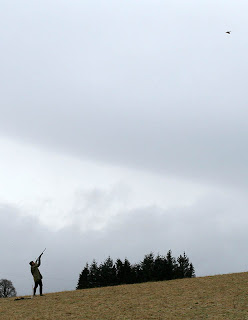
Here's Alistair taking a fine shot at a partridge on the first drive. If you look closely you can see the empty shell ejecting from his Benelli 20-bore; not something you'll see often at a driven shoot in Britain. What was it like shooting driven birds with a semi-auto? You'll have to read our February issue to find out (on sale at the beginning of Jan).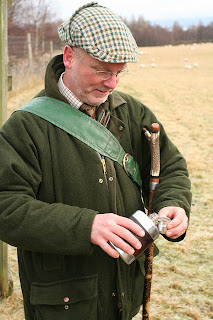
Among the many lovely people I met on this trip, I really must mention Mick Tarbet who drove the minibus on the second day. We chatted non-stop there and back, covering every subject from crows to muntjac to fishing flies. He's a knowledgeable chap, and I learnt some useful tricks with snares, "duck's arse" feathers and much more. Plus it turns out there are several people we both know, including Jim Tod at Tarvie. Small world.
I was touched when, at the end of the day, Mick insisted on giving me his stick, a lovely sturdy piece topped with the antler of a deer he shot. I anticipated problems getting it past airport security, but the staff at Edinburgh Airport didn't bat an eyelid - they just stuck a label round it and put it through as "oversize baggage". I shall look forward to using the stick, which will always bring back memories of the trip.
People sometimes tell me I must have the most amazing job, with loads of invitations to shoot. Well, it's not like that most of the time, but after this trip I really do feel very lucky indeed to be able to combine earning a living with my passion for shooting and the outdoors.
Tuesday 4 December 2007
Who's the dummy?

I'm off to the House of Commons tonight for a posh dinner with the All Party Group on Shooting & Conservation. "Airport-style security" warns the invitation, so this morning I cleared my pockets of anything that might be construed as an offensive weapon, including the rather fine Spyderco pocket knife that I normally carry everywhere.
It's all pretty pointless of course. Having relieved us of anything sharp and pointy, I've no doubt they'll serve us wine in eminently smashable glass bottles. But you have to play along with these characters; they have little commonsense, even less sense of humour, and they carry rigid Hiatt Speedcuffs designed to apply pain compliance. So I even removed the fishing flies that have taken up residence in my tweed cap, in case an eager security guard mistook them for some sort of secret weapon.
Which made it all the more alarming when I was idly fiddling with the lining of my suit jacket and felt these - a pair of dummy .17HMR rounds we'd used for a photo shoot months ago, and which had somehow slipped through a hole in my pocket. Oops! They're totally inert and harmless, of course, but I don't think that would have helped much.
Fingers crossed there are no more nasties lurking about my person. I wouldn't want to give them an excuse for the full bodysearch.
Sunday 2 December 2007
Tooth & Claw

What is Tooth & Claw? Sure it's a book, an image library and a website. But it's also a campaign, and an idea.
I've had a sneak preview of the book, and it's stunning. 200-plus pages of some of the best wildlife photography I've seen, by Peter Cairns and Mark Hamblin. Here are wolves, sea eagles, foxes, seals and wild cats like you've never seen them before.

We all love to look at beautiful photos of wildlife. It's like that moment when you're waiting for pigeons and a sparrowhawk screams past. Or you're watching through the binoculars and see a fox pouncing on a vole. You feel privileged to see one of nature's athletes doing what it does best.
But the breathtaking images are merely the window dressing for something much deeper. The book sets out to make us reassess how we feel about predators. Like the foxshooter's lamp, it shines a million-candlepower beam on something that was previously hidden in the dark.
The authors fearlessly tackle subjects from foxhunting to keeping pet cats to reintroducing predators like sea eagles, wolves and bears to Britain's countryside. They talk to people on all sides of the debate - preservationists, conservationists, scientists, shooters, keepers and hunters.
And which side are they on? Frustratingly, they don't let on. What comes through is their belief in talking openly and honestly about the way we live with predators.
That's not easy to do in an area where everyone starts from an entrenched position and an attitude of "you're either with us or against us". But that's what Peter Cairns and Mark Hamblin have done, and they've done it very well.
I think this book marks a turning point in the way we talk about predators in Britain. Some of the old school will find it hard to take, but I believe that the debate it sparks can only be good for shooting, shooters, the countryside, and for the predators themselves.
Find out more (and order a copy of the book) at the Tooth & Claw website.
Fish filleting made simple
Basically, it's a quick and easy way to remove the bones and leave the flesh and skin intact, ready for cooking.
First, gut the fish and trim off the head, tail and fins. Now put your knife down. You don't need it for the next bit - honest! Place the fish stomach-down on the chopping board with the tail end towards you and the head end away. Spread out the flaps you made when you slit the stomach, so it stands up on its own.
Now the clever bit. With your hands on either side, use your thumbs to press down hard on the backbone. You'll feel it give, as if you have squished the fish flat. Actually this is the backbone coming away from the flesh. Repeat all down the backbone.
Then pick it up, find the head-end of the backbone, and pull it away from the flesh. It will come away easily, taking most of the bones with it.
You can then fold the fish back together, cook it flat, or cut the two halves apart, depending on how you want to cook it.
I tried the technique with herrings, and it worked brilliantly. I wondered if it would be possible to slice through the flesh at the head, but leave the backbone intact. That could make it even easier to remove the backbone in one piece. I ran out of herrings to experiment with, but I'll try it next time.
Friday 23 November 2007
Fox shooting with Robert Bucknell
Rach and I spent today with Robert Bucknell, author of the fox-shooting bible 'Foxing with Lamp and Rifle', for a feature in the February issue (the one that goes on sale at the beginning of January).
He gave us plenty of background on his rifles, the techniques he uses, and his calls - plus some fascinating information about big cats roaming the countryside.
I plan to include his comments on big cats in the next podcast. Watch this space...
Wednesday 21 November 2007
Eating squirrel
Tuesday 20 November 2007
Squirrel shooting tactics

With the leaves falling fast, it's realistic to go after squirrels again – and that's what I did with my daughter Emma last weekend. That's her pictured, with a couple of greys, and a couple of long-eared non-squirrels that we kicked out of the brambles. She was shooting a 20-bore Beretta Silver Pigeon, with 25g Lyalvale Express 7s from justcartridges.com.
When I was her age, I used to spend hours hunting squirrels with my airgun. It's tricky, because they're skilful at hiding in even the barest-looking tree. But there are some tricks you can use to improve your chances. Going squirrel shooting with Emma reminded me of some of the lessons I learned long ago. Here's a few notes – feel free to add any tips of your own in the 'comments' section at the foot of this post.
• Every squirrel has a 'home' tree where it feels safe – most likely because it lives there, in a drey or a hole in the trunk. If you surprise it when it's out feeding, it will make a mad dash for its home tree. That gives you a chance to spot it, because they are very difficult to see until they move. Which is why it can sometimes pay off to move quickly, even noisily, through a wood when you're after squirrels.
• When you spot one making a dash through the trees, your best chance is to overtake it, and get between the squirrel and the tree it's making for. If it once makes its home tree, it stands a good chance of evading you completely. Since the squirrel has to move through the branches, while you are on the ground, this is often possible – but don't run with a loaded gun, and watch out for ditches, bramble bushes, rabbit holes etc.
• If you manage to overtake the squirrel, turn to face it; with luck it will stop and hide as best it can. If you're even more lucky, you may have stopped it on a tall spindly tree with no big branches to hide behind. If you're not so lucky, it may be a thick, tangled old oak with dozens of Vs for the squirrel to hide in. They are very good at hiding, choosing a V that shields them from almost all directions and flattening their body tight against the trunk.
• Legend has it that you can hang your coat on a bush, then walk round the other side of the squirrel's tree – and catch him by surprise while he hides from your coat. Well, I haven't met a squirrel that stupid. They hear you scrunching round the tree, and sidle round to keep out of sight.
• So what can you do? Well, it's a lot easier if there are two of you. Last weekend I acted as spotter, using a pair of binoculars to scan the likely places (in or just above a main V, although occasionally a squirrel will 'reach for the sky', and head up the furthest, thinnest branch available – more likely in fir trees, or trees with some leaf still on the branches). You're not looking for a whole squirrel, just a tell-tale wisp of furry tail, or a patch of grey fur. Then it's a question of bringing the gun into position as quietly as possible, pointing out the squirrel's location, and selecting an angle that allows the shot to hit a vital spot for a clean kill.
• And if you're on your own? Then your options are more limited. I usually start by moving around the tree slowly, and as silently as possible, scanning the branches all the time. Sometimes you'll spot a movement, or see a head peeping round as the squirrel tries to assess the threat. Other times you may just see a flick of tail. If you see nothing on the first circuit, move farther away from the tree and make another circuit. This lets you look into the Vs from a different angle.
• If that fails, there are two possible methods: either wait it out until the squirrel thinks you've got bored and wandered off (which could be a long time), or try lobbing a few stones or sticks into the tree in the hope of breaking its nerve so it makes a run for it. If you're well prepared (I wasn't!), you'll have a catapult and a few small stones in your pocket for this job – also good for rattling the dreys to see if any squirrels are at home.
Wolf Brother

I've been reading Wolf Brother, by Michelle Paver, a remarkable story about a boy living a hunter-gatherer life in prehistoric times. You'll love it or hate it; I loved it.
One of the striking things about the book is the level of detail about primitive skills and technology. Michelle took her research very seriously, not only studying archaeology and anthropology, but actually living with modern day hunter-gatherers such as the Sami of Lapland and the Inuit of the Arctic.
In her author's note she writes: "What does spruce resin taste like? Or reindeer heart, or smoked elk? ...Fortunately it's still possible to find out, at least to some extent, because parts of the Forest still remain. I've been there. And at times, it can take about three seconds to go back six thousand years. If you hear red deer bellowing at midnight, or find fresh wolf-tracks crossing your own; if you suddenly have to persuade a very edgy bear that you're neither threat nor prey..."
Michelle has also studied wolves very closely, and the book includes a great deal of detail about how wolves communicate, and what humans can understand from their body language, behaviour and sounds.
Perhaps what gripped me more than anything was the insight into the beliefs and thought-processes of hunter-gatherers - again drawn from Michelle's studies and direct experience of so-called 'primitive' people today. Much of what she writes underpins the modern sportsman's thinking. It goes to the heart of what it is to be a 'hunter', in tune with the natural world, and helps explain the paradox of caring for wildlife and also killing it.
Here's a taster:
It took Torak two full days to butcher the carcass. He'd made the buck a promise, and he had to keep it by not wasting a thing. That was the age-old pact between the hunters and the World Spirit. Hunters must treat prey with respect, and in return the Spirit would send more prey... After a final round of soaking and drying, he had a reasonable skin of rawhide for rope and fishing-lines... While the hide was drying, he cut the meat into thin strips and hung them over a smoky birchwood fire...
You can read more about Michelle Paver on her website. The book, Wolf Brother, is available at bookshops or at Amazon. You can also download the entire book in a series of podcasts here. It's the first book in a series that isn't yet finished - book 4 is complete, but there are more to come. I can't wait!
Monday 19 November 2007
Knife sharpening
The Blade Tech type, for instance, gives a workable edge in no time flat, but it takes quite a lot of steel off each time, and it's hard to slide the knife edge smoothly through, without judder that leaves ugly corrugations in the edge.
The Lansky system has proved easiest to use and get a really good edge, honed as smooth as you like. But it's a fiddly thing to set up and not very practical to carry with you in the field.
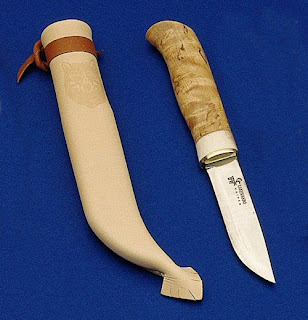
This weekend I decided to sharpen a knife that I've been using recently, and been very impressed with. It's a traditional Lapland type knife, made by Karesuando (I bought mine through Nordica Heat on ebay).
This knife has the typical 'Scandinavian' grind - basically a rectangular section piece of steel, with a primary bevel, then sharpened with a secondary bevel - the diagram below shows this in cross-section (As with all imges in this blog, clicking on the image will bring up a larger version).

With something like a Lansky sharpener, you can reproduce the secondary bevel accurately enough time after time to keep sharpening the knife. But if you want to use a flat stone in the field, the results will be disappointing.
My answer is to grind the knife at the angle of the primary bevel, removing enough 'meat' that the primary bevel becomes the blade edge - as shown in the diagram below.

To do this, you lay the blade on the stone (I used one of Jonny Crockett's 6000/1000 waterstones), so that the primary bevel is flat on the stone. Then push the blade over the stone so that, bit by bit, you 'strike off' the metal down to the dotted line in my diagram. The shape of the finished blade is shown in the diagram below.

It's important to keep each facet nice and flat, and don't let the knife pitch and yaw as you grind it - otherwise you end up rounding-off angles that should be nice and crisp. The trickiest bit is keeping the shape right as you work round the curve and up to the point of the blade.
The end result is a blade that is remarkably sharp (yes, you really can shave with it, especially if you finish it off on a leather strop), and is also easy to maintain in the field with a simple flat stone. Why is it easier to maintain? Because the whole depth of the primary bevel acts as a guide, helping you to keep the knife at the correct angle as you slide it across the stone. It is also a good strong edge, that won't be easily damaged by normal use.
Although you lose a bit of steel in arriving at the new blade shape, it should be possible to re-sharpen it with just a few strokes of the fine grit, so it should wear well from now on.
This knife has done a fine job of preparing a few squirrels and rabbits, and the edge is holding up well - I'll post again to let you know how it goes.
Footnote: For much more detail on knife steels, edge geometry and sharpening, see Chad Ward's Knife Maintenance & Sharpening. Chad is writing mainly about kitchen knives, but it's an excellent introduction to the subject generally.
Sunday 18 November 2007
Faulty logic

This banner ad on The Sun website caught my eye. It reads: "Are you against game hunting? Click here to preserve our wildlife!"
The clear implication is that 'game hunters' are a threat to Britain's wildlife - along with global warming, pollution and the rest.
Of course we know that the opposite is true, but I suppose it just shows that we've a long way to go in educating the public.
Friday 16 November 2007
Purdey Awards

Good to see the Duke of Northumberland's grey partridge project win the Purdey Award for Game & Conservation last night. I visited the estate at Alnwick a couple of years ago, and was very impressed with the work being done there by headkeeper Garry Whitfield and partridge ground keeper Kevan McCaig.
Pictured above is the Duke (in suit) flanked by Garry and Kevan, laden with their winnings, including a cheque for £4,000 and a jeroboam of Laurent Perrier champagne. At the back of the shot is Richard Purdey, who has been running the awards since 1999.
The awards ceremony was held, as always, in the famous Long Room at Purdey's shop in South Audley Street - a fascinating venue with the walls covered with paintings, old guns and memorabilia from Purdey's long history.
Unfortunately I wasn't able to stay long after the presentation, as I had to dash off to another event - but the silver lining was that there I met game chef Mark Gilchrist who came up with some great ideas for features for the magazine... watch this space!
Thursday 15 November 2007
Posh rabbit pie
RABBIT, WILD MUSHROOM AND PRUNE PITHIVIER
WITH AN ENGLISH MUSTARD SAUCE
INGREDIENTS
½ x confit wild rabbit, cut into approx ½ “ pieces
125g cooked wild mushrooms
15 x diced prunes
250g puff pastry
20g cooked, finely chopped shallots
mixed with, 1 clove crushed garlic cooked
Salt and pepper
½dl brandy
Eggwash
FOR THE SAUCE
½ litre supreme sauce
English mustard
METHOD
1. In a bowl mix together the rabbit, wild mushrooms, prunes, shallots and garlic.
2. Season with salt and pepper.
3. Add some brandy to taste.
4. Split the mix into 5 equal portions.
5. Roll out the puff pastry and cut out 5 rings with a 10cm diameter cutter.
6. Cut out another 5 rings with a 12-13cm diameter cutter.
7. On the small rings, put the rabbit mix in and cover with the larger ring of pastry and seal the edges.
8. Place in the fridge for one hour to rest.
9. When ready to cook, brush with the eggwash and score the top.
10. Bake in an oven @ 180C for 15-20 minutes.
11. Boil the supreme sauce and add English mustard to taste.
Saturday 10 November 2007
Near miss with a falling pheasant
I've been trying to get some video of pheasants flying at the shoot today... this one fell a bit too close for comfort!
Thursday 8 November 2007
Is this the best rabbit pie in the world?
View the recipe here.
Tuesday 6 November 2007
Squirrel shooting part II - the stew
 Following my squirrel shooting exploits at the weekend, here is the squirrel stew cooked up by Vikki, who declared it "delicious".
Following my squirrel shooting exploits at the weekend, here is the squirrel stew cooked up by Vikki, who declared it "delicious". Update: Here's Vikki's recipe...
Ingredients
(Serves 2. Preparation time: 5-10 minutes, Cooking time: 1 hr 40 mins)
• 3-4 squirrels (skinned, gutted and cut into joints)
• 2 carrots (sliced 1cm thick)
• 1 medium onion (sliced)
• 1 large green pepper (roughly chopped)
• 3 celery sticks (sliced approx 1cm thick)
• 1 can of chopped tomatoes
• 1 can of white beans
• 1⁄2 pint vegetable stock
• 2 large potatoes (sliced)
• 1 large courgette (thickly sliced)
• 3 tbs flour
• Dash of olive oil
• Salt and pepper
• Cajun spice
Method
Preheat oven to 200C/400F/ Gas mark 6. Heat the carrots, onions, pepper and celery with a little oil in a large, lidded pot.
Coat the squirrel pieces with seasoned flour, fry with a dash of oil until brown, and add to the pot. Deglaze the frying pan with a little stock, pour into the pot, and add the remaining stock.
Stir and simmer for 10 mins, then add the chopped tomatoes, plus cajun spice to taste. Simmer until the meat is tender (approx 11⁄2 hours) stirring every 30 mins.
Blanch the potatoes for 5 mins in boiling water, drain and put in a roasting tin with the courgettes. Drizzle olive oil on top, season, and slow roast for 11⁄2 hours at 100C/200F, turning every 30 mins.
Add the white beans to the stew 5 mins before serving. Serve with roasted potatoes and courgettes and a good granary bread.
Sunday 4 November 2007
Squirrel shooting part I - ingredients
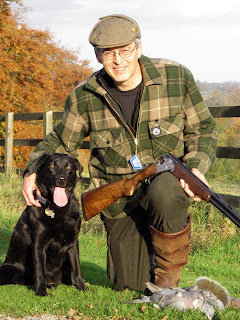
Today I went to my parents' to shoot some squirrels - they are over-run with the things. In the last fortnight, my dad and I between us have shot 22.
They just weren't playing ball today though. With so much leaf still on the trees, if the squirrels aren't out feeding then there's little chance of spotting one.
So it became more of a stroll in the woods with the dog and the gun. In weather like this, with the leaves all gold and brown against a blue sky, I've no complaints.
Final tally for the day: 1 squirrel and 2 pigeons - all of which I'm about to prepare for a brave soul in the office who is keen to see what squirrel tastes like.
Friday 2 November 2007
Video - coming soon
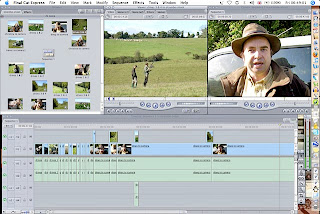 I've been working on a short video from my visit to the Elcombe Shoot in Wiltshire, where I met our Beater of the Year award-winner, Doug Titt.
I've been working on a short video from my visit to the Elcombe Shoot in Wiltshire, where I met our Beater of the Year award-winner, Doug Titt.Sounds easy when I type it, but it's a massive learning curve for me! I recently ebayed a whole lot of stuff that had been lying in cupboards for ages, and spent the proceeds (also on ebay) on a shiny almost-new Canon XM2 camcorder.
 The camera's first day out was at Elcombe. The results were quite satisfying, and I was able to extract the audio to use in my latest podcast. But that's just the start of it. I've had to get a copy of the editing software, Finalcut Express, and learn how to (a) get the video off the camera and into the laptop, and (b) use the editing software to snip out the bits I want and join them together.
The camera's first day out was at Elcombe. The results were quite satisfying, and I was able to extract the audio to use in my latest podcast. But that's just the start of it. I've had to get a copy of the editing software, Finalcut Express, and learn how to (a) get the video off the camera and into the laptop, and (b) use the editing software to snip out the bits I want and join them together.The photo at the top of this post is a screenshot from my laptop, as I work on the footage. There's still a way to go before I'm happy with it, and then I have to work out how to save the finished movie in the right format, and upload it so that people can see it.
I'll get there in the end - meanwhile you'll just have to be patient!
Wednesday 31 October 2007
Ted Andrews illustration
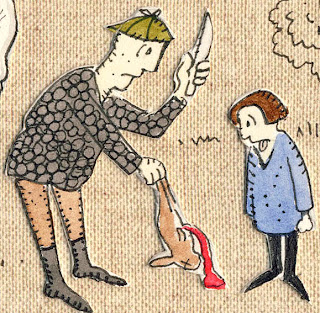 I love the regular cartoons that Ted Andrews creates for the magazine, but he has really surpassed himself with a special illustration for Jackie Drakeford's article in our Christmas issue (out at the end of November). This is a detail from his piece, which shows a day's rabbiting.
I love the regular cartoons that Ted Andrews creates for the magazine, but he has really surpassed himself with a special illustration for Jackie Drakeford's article in our Christmas issue (out at the end of November). This is a detail from his piece, which shows a day's rabbiting.If you're a fan of Ted's work, check out our online auction of one of his original works, being sold to raise funds for NOBs.
Saturday 27 October 2007
Leatherman Charge Ti
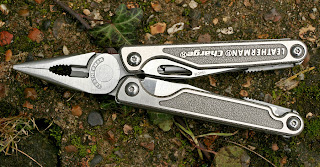
Being in the business of outdoors journalism, over the years I've used just about every multi-tool ever invented.
Many are rubbish. Some are ok. But to my mind Leatherman have always been the best - and this is the best Leatherman I've seen so far.
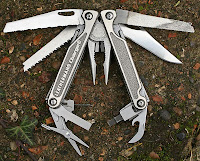 It's the Charge Ti. Like any multi-tool, it's got a list of tools and features - needlenose pliers, straight and serrated blades, saw, screwdrivers, can/bottle opener, etc.
It's the Charge Ti. Like any multi-tool, it's got a list of tools and features - needlenose pliers, straight and serrated blades, saw, screwdrivers, can/bottle opener, etc.But just comparing a list of gadgets is missing the point. Many multi-tools feel like a lump of scrap metal in your hand. This one just feels right. Like a well-balanced knife or hammer, it fills your hand with a good, solid feel. You feel in control. The edges are rounded so they don't dig into your palm, and the stippled surface gives extra grip.
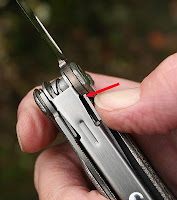 Other tools have a habit of pinching you as you fold or unfold them. Don't ask me how, but the Leatherman simply doesn't. Good design, I guess. That good design is apparent in all sorts of little details. Look at the liner lock that holds the main blades open, for instance (highlighted by the red arrow in the photo - click the pic for a larger version). It locks automatically as you open the blade (which can be done one-handed), it holds the blade safely open, yet you can release it and close the blade again with one hand when you're done. And the locking mechanism for the smaller tools is effective and easy to use too.
Other tools have a habit of pinching you as you fold or unfold them. Don't ask me how, but the Leatherman simply doesn't. Good design, I guess. That good design is apparent in all sorts of little details. Look at the liner lock that holds the main blades open, for instance (highlighted by the red arrow in the photo - click the pic for a larger version). It locks automatically as you open the blade (which can be done one-handed), it holds the blade safely open, yet you can release it and close the blade again with one hand when you're done. And the locking mechanism for the smaller tools is effective and easy to use too.Plus the Charge Ti has a pair of scissors built in, something that I find really useful (eg for fishing) and which is lacking on many tools.
What really impresses me about the Charge Ti is the sheer quality of engineering. Some tools actually rattle if you shake them. No chance of that here. Everything fits together like the lockwork on a fine gun.
This is a top quality tool that will last a lifetime and is a real pleasure to use. More info on the Whitby & Co website. Price around £120, with leather or nylon pouch.
Dubarry Wexford boots
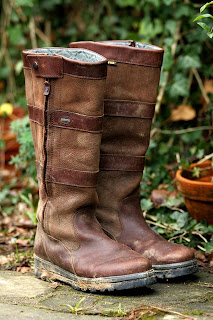
As someone brought up in rubber wellies or leather walking boots, I was always a little wary of people who wore leather wellies. It just didn't seem natural.
Then a year or so ago I got a call from a very nice person at Dubarry who insisted, in the nicest possible way, that I tried their Wexford boots.
Well, it seemed rude to refuse, but I was sure I'd hate them and go back to rubber wellies as soon as I'd given the Wexfords a token try-out.
I was wrong! These really are the most comfortable wellies I've ever used. They insulate your feet much better than rubber, so you don't get frozen toes waiting for the drive to start. They breathe well, too, so your feet don't get sweaty. And they are even comfortable enough to walk in. I won't be using them for hill stalking - they don't fit tight enough round your ankles to give the support of a walking boot - but they're fine for a day's beating.
Plus they have a Gore-Tex lining, so they really are totally waterproof - earlier this year I stood in a Scottish loch, with the water lapping round the upper leather band, for two hours, and not a drop came through.
So I don't care if my so-called friends make jokes about musketeers or village people. I'm throwing away my rubber wellies and wearing these in future. I'll have the last laugh when their toes freeze!
Other points: the zips look nice but I've found I never bother - the boots slip on and off easily without undoing them. And the soles have a really good pattern, similar to a Vibram sole, which gives excellent grip on rock and grass.
Tempted? See them here but be warned - they cost £275!
Meet the ferrets
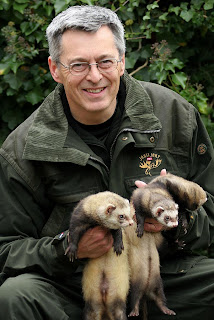
I realised I hadn't introduced my ferrets on this blog yet, and with the ferreting season approaching I thought it was long overdue - so here they are. An entire hob and two jills, they have a large run and two hutches at the end of the garden. I feed them on James Wellbeloved complete ferret food, which saves all the bother of feeding raw meat (like the ferrets hiding rotting chunks of meat in their bed, for instance).
I have a selection of purse nets (about half of them bought, and the other half made myself) and a 50-yard long-net, and I use a Deben Ferret Finder 3 (best invention ever). Sometimes, such as when there's just too much undergrowth, I'll shoot the rabbits rather than net them.
I should be out ferreting a few times from November onwards, so I'll add a few posts to let you know how I get on.
Friday 26 October 2007
Just what we don't need
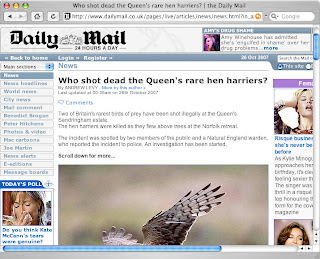 Sad to see this story in the Daily Mail today, and on the paper's website. On the face of it, someone at the Queen's Sandringham Estate in Norfolk was seen to shoot two hen harriers. But look closer and it's all supposition - someone from Natural England, and a couple of 'members of the public' heard a bang, and thought they saw what they thought was a hen harrier fall from the sky. Twice (a right and left?). Add two and two to make five - and you have a headline-grabbing story about the Queen's gamekeeper shooting rare birds. A similar story appears on the BBC website.
Sad to see this story in the Daily Mail today, and on the paper's website. On the face of it, someone at the Queen's Sandringham Estate in Norfolk was seen to shoot two hen harriers. But look closer and it's all supposition - someone from Natural England, and a couple of 'members of the public' heard a bang, and thought they saw what they thought was a hen harrier fall from the sky. Twice (a right and left?). Add two and two to make five - and you have a headline-grabbing story about the Queen's gamekeeper shooting rare birds. A similar story appears on the BBC website.So how did it make the papers? Well there wasn't a journalist standing watching at the time. So one can only assume that someone from Natural England - either officially or unofficially - called up the paper with their 'hot news story'.
And what really happened? Time will tell. In the meantime, where is the quote from NGO or BASC emphasising all the sound conservation work that's done by shooters and keepers? I'm prepared to bet that neither the Mail nor the BBC thought to ask them for a comment.
Update Wed 31 Oct: Hard to believe that Prince Harry is now in the frame for the alleged killing (story here). Apparently "the Prince and a friend were the only people known to be shooting in the area last Wednesday when the two hen harriers were killed".
There are still huge gaps in the story though. Like, where are the dead harriers? And why is is that the spokesman for Natural England "heard a shot and saw one of them fall and heard another shot and saw that one fall"? Does sound travel faster than light in Norfolk these days?
Thursday 25 October 2007
Robbery outside Shooter office
 Breaking news, as they say on the telly: this is a bit off topic, but within the last half hour there was a robbery on a security van outside the window of the Shooter office. The photo shows the view from our office window, as more and more police cars pile up outside.
Breaking news, as they say on the telly: this is a bit off topic, but within the last half hour there was a robbery on a security van outside the window of the Shooter office. The photo shows the view from our office window, as more and more police cars pile up outside.Update: Piecing together comments from various people, it seems that a lone woman security guard was collecting cash from a local shop. Two lads spotted an opportunity, pushed her to the ground and made off with the bag. They hadn't really thought it through, however - their car was parked 200 yards up the side street, and several people saw them get in and drive off, and someone got the car's number. The car belonged to one of them, so the cops won't have too hard a job tracking them down.
Monday 22 October 2007
The Wild Gourmet effect
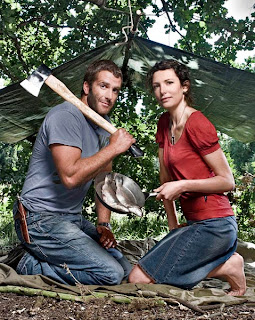
"Shooting needs its own Ray Mears"
Several shooters have commented to me about the new flush of game cookery programmes on British TV. You can hardly turn on the telly now without seeing some earnest-looking chap (or girl) walking out with a gun, shooting some wildlife, chopping it up and eating it - all the while explaining why it's the natural, sustainable and tasty thing to do.
Great! This all helps to get our message across, and portray shooting in a good light. The fact that TV editors are prepared to let this happen proves that there's been a mood change. Shooting to eat is acceptable again. Carrying and using sporting guns is acceptable again.
But there's something even more important going on here.
People tend to think in stereotypes. We all do it. What picture comes into your head when someone says... 'fireman', 'rock star', 'teacher'? Now think hard about that image. Is it accurate? Is it favourable? Are all firemen, rock stars or teachers like that?
Say 'gamekeeper' or 'game shooter' to the average member of the public and they picture a grumpy, arrogant, tweed-clad fool with a gun, killing everything in sight until there's nothing left to kill. It's not fair, but they do.
We need to replace that image with something fit for the 21st centry - and the quickest, most effective way to do that is with TV personalities. Shooting needs its own Ray Mears. We ain't got one yet, but Tommi Miers and Guy Grieve, Channel 4's The Wild Gourmets (pictured above), are the closest we've come so far.
I'd like to think they were the result of some far-thinking PR on the part of the shooting organisations. I suspect, however, it's more of a happy accident.
Comments? Click on the 'comments' link in the next line, and have your say.
Sunday 21 October 2007
Sporting Shooter podcast - episode 6
Friday 19 October 2007
Lords v Commons
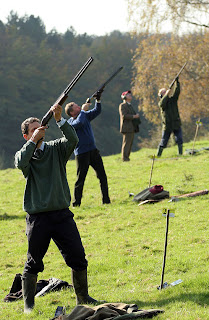
I'm just back from the annual Lords v Commons clay shoot, organised by BASC. This year it was run as a simulated game day at Squerryes Court, near Westerham in Kent.
It was a fun and interesting day, although not quite as I'd expected. Having never attended this event before, I'd imagined a bunch of MPs who'd never handled a gun, being introduced to the sport. In fact it was more like preaching to the choir - all the guns looked like they spent most of their spare time on a grouse moor or a driven pheasant peg. Still, it was a good chance to hear about the political side of our sport from the horse's mouth.
At lunch we had short presentations from Mark Elliott of NOBs, and Judith Howell, BASC's politics and policy officer. Discussions afterwards ranged from the Revenue going after beaters' "wages", to the Shoot Assurance Scheme, to whether big commercial shoots are a threat to the sport.
Plus there's a bit of concern about the trophy. Apparently it's gone missing and no-one is owning up to knowing where it is. Policians, eh - can't trust 'em!
Filter tip

Here's a smokers' tip from Mark Elliott of NOBs... To stop your fag packet getting soggy and crushed in your pocket, buy one of those tins of strong mints, eat the mints (or throw them away!) and keep your cigs and lighter in the tin. Handy for stalking, wildfowling etc, as well as beating. If you need to move quietly, just remember to pack it tight so it doesn't rattle.
Thursday 18 October 2007
I meet our award-winning beater
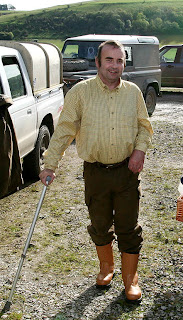
Today I joined the Elcombe shoot at Alvediston, near Salisbury in Wiltshire, for their first day of the season - and met Doug Titt, the winner of our Beater of the Year Award for '06-07.
It's a real family affair, with farmer Trevor running things, his wife Sue helping out and cooking up a hearty lunch, and daughter Christina keepering. It was a glorious sunny day, and everyone was enjoying getting back out shooting again after the close season. You couldn't ask for a warmer welcome than I received, and the whole atmosphere of the day was fabulous.
Doug himself is a real inspiration. A keen pigeon shooter, he had been beating and picking-up at Elcombe for 6 or 7 years when, last July, he suffered a stroke. He was in hospital for more than 3 months, but couldn't wait to get back to the shoot: "That's all that's worth living for," he told me. "When I was in hospital, it just wasn't worth waking up in the morning."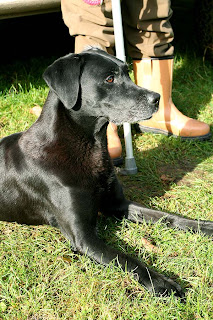
He went out on the shoot at the end of last season, first just sitting in the pick-up and then getting out to work his black lab, Missy. That's when keeper Christina nominated him for our award - and when Mark Elliott of NOBS and myself judged the entries, Doug's story really stood out.
Doug was great company - as were the rest of the bunch at Elcombe. He's always ready with a quip or a joke, and keeps a very positive outlook despite the difficulties he has to overcome: he suffers fits every now and again, which he finds very draining, and he's bought extra-warm fur-lined boots as he finds his feet get very cold now.
You won't hear him complaining though - he's always looking ahead. In fact, he told me he'd like to look into training dogs for drug detection work as it would be a new challenge while still doing what he loves best, working with dogs.
Next time I'm under the weather and starting to feel sorry for myself, I'll think of Doug!
Listen to my interview with Doug on the podcast.
Special thanks to Nestle Purina BETA dogfood and Runnarkop for providing a superb collection of prizes for Doug and his colleagues on the beating team at Elcombe. Thanks also to Mark Elliott and NOBs for their support of this award.

